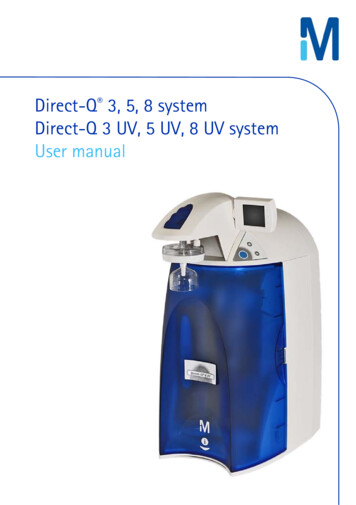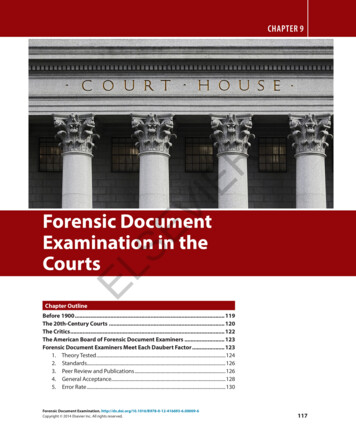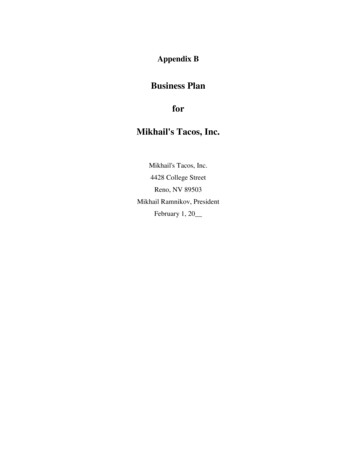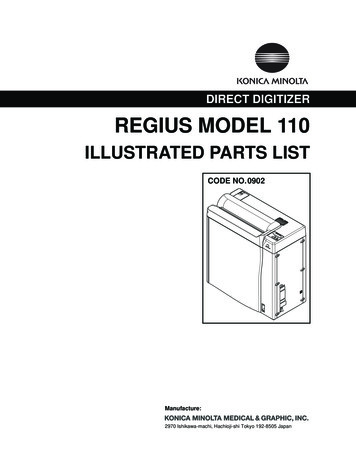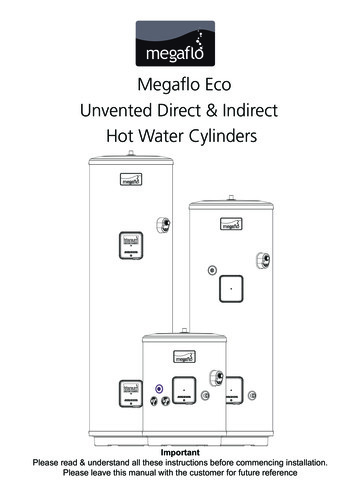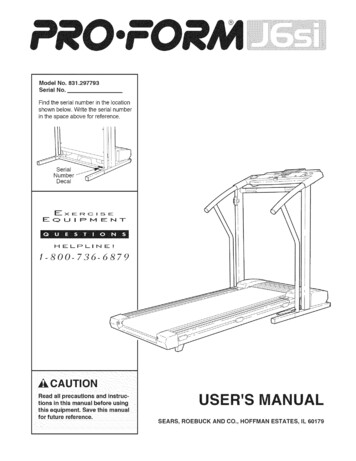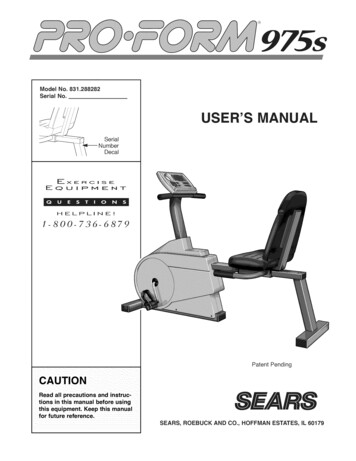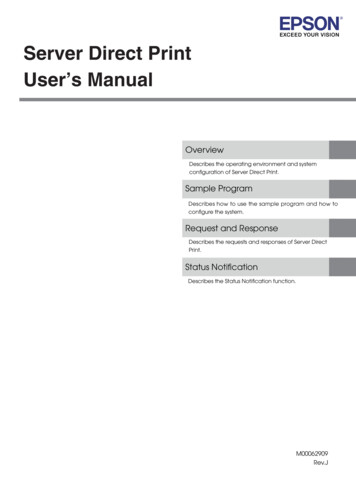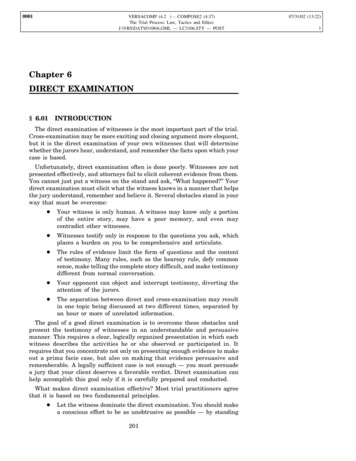
Transcription
0001VERSACOMP (4.2 ) – COMPOSE2 (4.37)The Trial Process: Law, Tactics and EthicsJ:\VRS\DAT\03106\6.GML --- LC3106.STY --- POSTChapter 6DIRECT EXAMINATION§ 6.01INTRODUCTIONThe direct examination of witnesses is the most important part of the trial.Cross-examination may be more exciting and closing argument more eloquent,but it is the direct examination of your own witnesses that will determinewhether the jurors hear, understand, and remember the facts upon which yourcase is based.Unfortunately, direct examination often is done poorly. Witnesses are notpresented effectively, and attorneys fail to elicit coherent evidence from them.You cannot just put a witness on the stand and ask, “What happened?” Yourdirect examination must elicit what the witness knows in a manner that helpsthe jury understand, remember and believe it. Several obstacles stand in yourway that must be overcome: Your witness is only human. A witness may know only a portionof the entire story, may have a poor memory, and even maycontradict other witnesses. Witnesses testify only in response to the questions you ask, whichplaces a burden on you to be comprehensive and articulate. The rules of evidence limit the form of questions and the contentof testimony. Many rules, such as the hearsay rule, defy commonsense, make telling the complete story difficult, and make testimonydifferent from normal conversation. Your opponent can object and interrupt testimony, diverting theattention of the jurors. The separation between direct and cross-examination may resultin one topic being discussed at two different times, separated byan hour or more of unrelated information.The goal of a good direct examination is to overcome these obstacles andpresent the testimony of witnesses in an understandable and persuasivemanner. This requires a clear, logically organized presentation in which eachwitness describes the activities he or she observed or participated in. Itrequires that you concentrate not only on presenting enough evidence to makeout a prima facie case, but also on making that evidence persuasive andrememberable. A legally sufficient case is not enough — you must persuadea jury that your client deserves a favorable verdict. Direct examination canhelp accomplish this goal only if it is carefully prepared and conducted.What makes direct examination effective? Most trial practitioners agreethat it is based on two fundamental principles. Let the witness dominate the direct examination. You should makea conscious effort to be as unobtrusive as possible — by standing20107/31/02 (13:22)1
0002VERSACOMP (4.2 ) – COMPOSE2 (4.37)The Trial Process: Law, Tactics and EthicsJ:\VRS\DAT\03106\6.GML --- LC3106.STY --- POST202DIRECT EXAMINATIONCH. 6out of the way, keeping your questions short and simple, andtrusting your witnesses. § 6.02Prepare your witnesses in advance to give complete and descriptivetestimony. The better prepared your witnesses are, the easier it willbe for you to fade into the background and let them tell their ownstories.EXAMPLE OF A DIRECT EXAMINATION 1PLAINTIFF’S ATRTORNEY : We call the plaintiff, Barry Phillips.[Plaintiff walks to the witness stand with the aid of a cane.]BAILIFF: Raise your right hand. Do you swear or affirm to tell thetruth, the whole truth and nothing but the truth?WITNESS: I do.Q: What is your name?A:Barry Phillips.Q: Where do you live?A:1130 South Stewart Avenue, here in Bayshore.Q: How long have you lived here?A:All my life, forty-eight years. I moved into the house on StewartAvenue eighteen years ago when I got married.Q: Any family?A:Yes, my wife Kerry, and two children, Laura and Kim. Laura issixteen and Kim is thirteen.Q: Where do you work?A:Finderson Engineering and Architects.Q: How long have you worked there?A:Twenty-three years. I started as a draftsman, and rose to chief fieldengineer. Then I was in the bus wreck and my knees got all smashedup, and now I’m back working as a draftsman again.Q: Let’s start at the beginning. Where did you go to school?A:In 1972, I graduated from Englewood High School and enteredIllinois Institute of Technology to study design engineering. I didsome graduate work at M.I.T., and then got a job with FindersonEngineering in 1979.Q: Doing what?A:I started as a draftsman. That’s the usual entry level position. Youdo final drawings of other people’s construction plans.Q: How was your health back then?A:1It was fine. Except for the flu, I had never really been sick. I hadno problems as far as I know.Adapted from FRANCIS X. BUSCH, LAWANDTACTICSINJURY TRIALS, vol. 3: 397–418 (1960).07/31/02 (13:22)241/1
0003VERSACOMP (4.2 ) – COMPOSE2 (4.37)The Trial Process: Law, Tactics and EthicsJ:\VRS\DAT\03106\6.GML --- LC3106.STY --- POST§ 6.02EXAMPLE OF A DIRECT EXAMINATIONQ: How about your legs?A:They were fine. I broke my right leg once sliding into third basein a freak accident. I was playing on the company softball team.Q: When was that?A:In 1983.Q: What happened to your leg?A:I guess it healed. I was able to play softball the next year, and itnever gave me any problems again.Q: Will you describe your jobs over the next few years?A:Sure. In 1985, I was promoted to the position of estimator. In 1987,I was made an assistant design engineer and later that same yearI was promoted to field engineer. In 1993, I was made chief fieldengineer.Q: What were your responsibilities as chief engineer?A:I supervised all on-site architectural engineering projects forFinderson. That meant I had to travel all over the Midwest. Wemight have as many as six construction projects going at once. Thiswas what I had always wanted to do. I usually delegated most ofthe preconstruction planning, but I loved to direct the actualconstruction. That is when most of the crucial decisions had to bemade. For instance, we might be working on the steel frame fora twenty-story building, and a steel worker would notice that thegirders were not lining up properly. Then it was a challenge to findand correct the problem. Sometimes it was a risky job. I had to beable to climb around the steel framework like the steelworkers,testing for alignment and tension and so on.Q: Did this job require a good memory?A:Yes, of course. You have to be able to remember lots of details aboutdifferent projects. You can’t carry sixty sheets of blueprints withyou when you’re climbing steel girders twenty stories above ground.Q: Directing your attention to April, 2002, were you still working aschief field engineer?A:Yes.Q: At what salary?A:My base salary was 95,000 a year. I also averaged about athousand a month in bonuses based on the completion of projectsunder budget.Q: Do you remember the events of April 20, 2002?A:God, yes. That was the day of the bus wreck.Q: What happened? Start at the beginning of the day.A:Well, my car was in the shop, so I went to catch the bus to get towork. I walked to the corner of Stewart and Miller Street and goton a downtown bus.07/31/02 (13:22)73203
0004VERSACOMP (4.2 ) – COMPOSE2 (4.37)The Trial Process: Law, Tactics and EthicsJ:\VRS\DAT\03106\6.GML --- LC3106.STY --- POST204DIRECT EXAMINATIONCH. 6Q: About what time?A:About 8:20 a.m.Q: Did you pay your fare?A:Yes.Q: What kind of bus was it?A:A regular city bus that said Bayshore Transit Authority on the side.Q: What did you do after you boarded the bus?A:I sat down in the second seat, next to the window, and startedreading over some preliminary estimates prepared by my staff.Q: Can you describe the seating in more detail?A:Sure. I was in a two-person seat, next to the window. There wasno one beside me. I was facing the front, on the right side. Therewas one seat in front of me.Q: Did anyone sit there?A:Yes, one person, but she got off before the wreck.Q: Did you know anyone else on the bus?A:No, I rarely ride the bus.Q: How much space was there for your legs?A:Well, of course I never measured it, but it was pretty close, sortof narrow for your legs. I would say six to eight inches or so.Q: Would you say more or less room than in a coach airplane seat?A:About an inch or two less. My knees brushed against the seat backQ: What did that seat back look like?A:It was a flat sheet of metal of some kind, probably aluminum.Q: Do you have any familiarity with scale models?A:Of course, we work with scale models all the time in constructionengineering.Q: Would you be able to recognize a scale model of the bus your wereriding?A:Sure, I think so.ATTORNEY: Your honor, may the witness step to the table and examineplaintiff’s exhibit one?COURT: Yes.Q: Mr. Phillips, look at the exhibit. Can you tell what it is?A:Yes, it’s a good scale model of the inside of the bus I was ridingin.Q: Is it fair and accurate, especially with reference to the front seats?A:Yes.Q: What about the view out the front window?07/31/02 (13:22)114
0005VERSACOMP (4.2 ) – COMPOSE2 (4.37)The Trial Process: Law, Tactics and EthicsJ:\VRS\DAT\03106\6.GML --- LC3106.STY --- POST§ 6.02A:EXAMPLE OF A DIRECT EXAMINATIONYes, that looks correct.Q: Will this exhibit help you in explaining what happened next?A:Yes.ATTORNEY: We offer plaintiff’s exhibit one into evidence as an illustrative exhibit.COURT: It will be received.ATTORNEY: May I move exhibit one to a position in front of the jurybox and have the witness step to the model and refer to it whiledescribing the next few events?COURT: Yes.Q: Will you indicate where you were sitting?A:Right here, in the right-hand seat, second from the front.Q: What happened next?A:I was reading my reports and not paying much attention, whenthere was a terrible crash.Q: What was the first thing you noticed?A:Well, it all happened very fast. I remember hearing the squeal oftires and I felt myself floating out of the seat. It was very quietand I remember trying to reach out to grab this metal bar on theseat in front of me but my arms wouldn’t move. For a moment Ifelt sort of suspended in midair, and then my face smashed intothe top of the seat in front of me. I hit the metal bar, here, andI blacked out.Q: Do you remember anything else?A:I remember looking out the front window while this all was goingon, and seeing nothing — no street, no sky, or anything. Then ina fleeting second I realized that the reason I couldn’t see anythingwas because I was looking at the back end of another bus right infront of us, only a few inches away.Q: You may sit down. What happened next?A:Everything was black. My eyes felt like they were open but Icouldn’t see. I could hear voices way off in the distance. I thoughtI was dead and started to cry. I thought I would never see Kim andLaura again.Q: Do you remember anything else from the scene of the accident?A:No.Q: What is the next thing you remember?A:Waking up in a hospital bed. My glasses were gone and there werebandages all over my head. I tried to move but couldn’t. At firstI was just numb, then my head and legs began to ache. Sometimesthere were shooting pains in my legs. I don’t remember much fromthose first few days; they — the nurses — kept giving me shots,and I would fall into a sort of half-sleeping stupor.07/31/02 (13:22)176205
0006VERSACOMP (4.2 ) – COMPOSE2 (4.37)The Trial Process: Law, Tactics and EthicsJ:\VRS\DAT\03106\6.GML --- LC3106.STY --- POST206DIRECT EXAMINATIONCH. 6Q: Do you remember hearing anything?A:No. Sometimes there would be voices, sort of indistinct and faraway.Q: What happened next?A:I became increasingly aware of myself, and slowly recovered myconsciousness. As I did, the pain in my legs became worse. It is hardto be precise, because I had no sense of time.Q: Can you describe the pain?A:I have never felt anything quite like it. By comparison, the painI felt when I broke my leg back in 1983 was nothing. This was likea constant itch, and I wanted to hit my legs or cut them off to makeit go away. At times there would be sudden pains like when youcrack your shin against a table — sometimes a series of ten spurtsof pain in a second or two. Sometimes the nurses would come inand hold me down by my shoulders and I would realize that I wascrying and screaming. I don’t remember much else. The pain shutout everything else around me.Q: Do you remember your wife being there?A:No. All I was conscious of was the pain. I do remember the firsttime I saw Kelly there. The pain had subsided, and I saw herlooking at me. I said hi and asked what time it was. She startedcrying and said I’d been in the hospital for ten days.Q: What else did you notice?A:That my legs were both in casts from the foot to mid-thigh.ATTORNEY: Your honor, may I approach the witness with an exhibit?COURT: Yes.Q: Showing you plaintiff’s exhibit two, do you recognize it?A:Yes. That’s a photograph of me in the hospital bed with my legselevated and the casts on.Q: Is it accurate?A:Yes.ATTORNEY: We offer this into evidence as plaintiff’s exhibit two. Wehave already supplied opposing counsel with a copy.COURT: Received.ATTORNEY: We have copies for the jury and the court. May I distributethem?COURT: Yes, go ahead.Q: How long did you wear these casts?A:Six weeks.Q: Any problems?A:Other than the pain from what used to be my knees, the only otherproblem I had was itching under the cast. It felt like little bugs were07/31/02 (13:22)217
0007VERSACOMP (4.2 ) – COMPOSE2 (4.37)The Trial Process: Law, Tactics and EthicsJ:\VRS\DAT\03106\6.GML --- LC3106.STY --- POST§ 6.02EXAMPLE OF A DIRECT EXAMINATIONcrawling on my legs, and I couldn’t scratch it because it was underthe casts.Q: What kind of treatment did you receive?A:Twice a day, they would come in and put me in a metal contraptionthat fitted under my arms. It was like a cage on wheels and movedwhen you pushed with your foot. They would tell me to try to walk.Q: With casts on both legs?A:Yes.ATTORNEY: Your honor, may I approach the witness with an exhibit?COURT: Of course.Q: Showing you plaintiff’s exhibit three, do you recognize it?A:Yes. That’s a photograph of me in the metal cage during a therapysession, taken by my wife.Q: Is it accurate?A:Yes, i
Q: What is your name? A: Barry Phillips. Q: Where do you live? A: 1130 South Stewart Avenue, here in Bayshore. Q: How long have you lived here? A: All my life, forty-eight years. I moved into the house on Stewart Avenue eighteen years ago when I got married. Q: Any family? A: Yes, my wife Kerry, and two children, Laura and Kim. Laura is sixteen and Kim is thirteen. Q: Where do you work? A .
